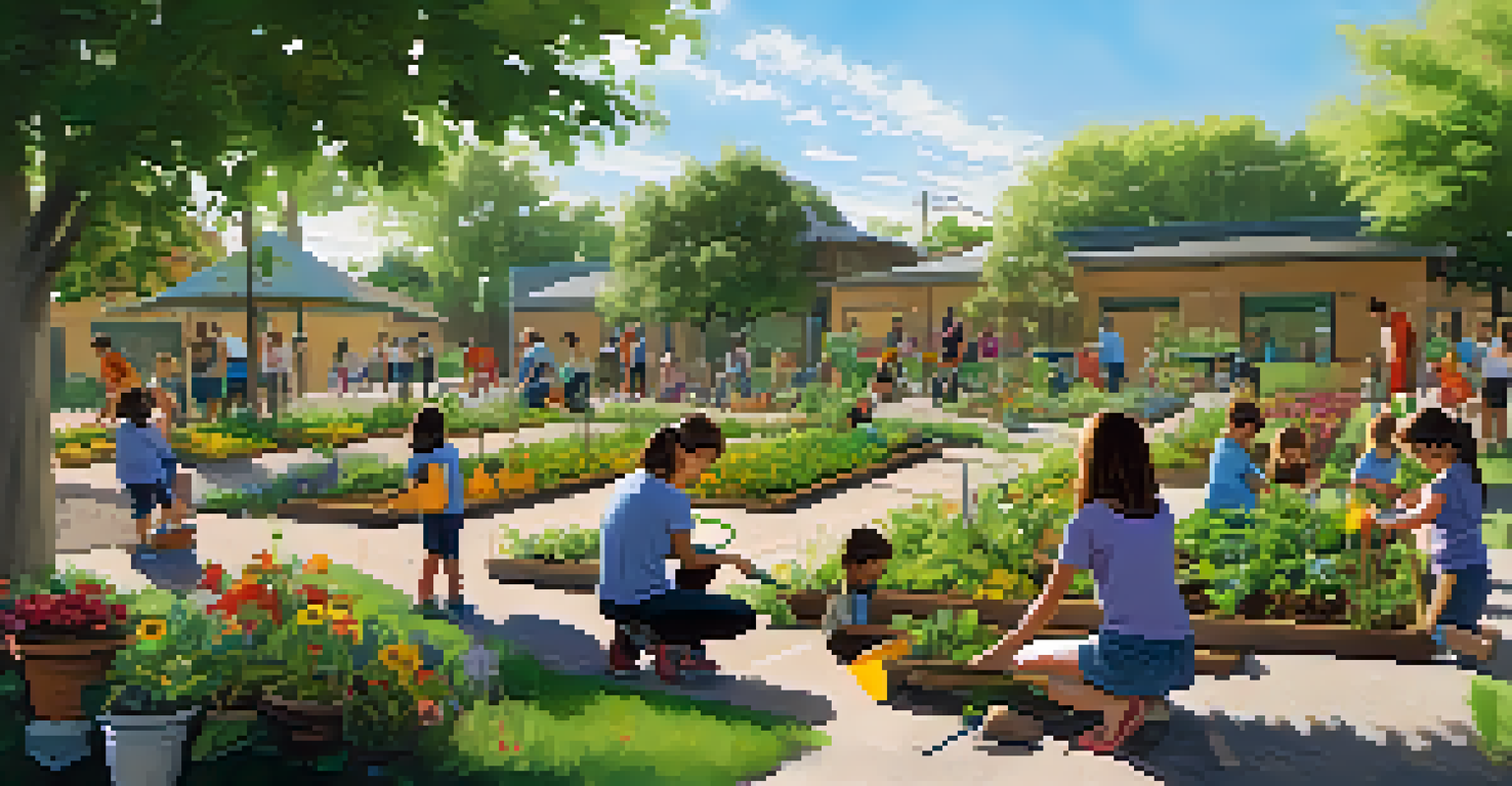The Role of Parks in Enhancing Austin's Community Health

Parks as Vital Community Hubs in Austin
Parks serve as essential gathering spaces for Austin residents, fostering connections and camaraderie. By providing venues for social interactions, they help build a sense of belonging within neighborhoods. This communal aspect encourages people to engage with one another, which can significantly enhance mental well-being.
In every walk with nature one receives far more than he seeks.
Additionally, parks often host community events, such as farmers’ markets, festivals, and fitness classes. These gatherings not only bring people together but also promote local businesses and encourage healthy lifestyles. The vibrant atmosphere of these events showcases the unique culture of Austin, making the parks a true reflection of the community.
Furthermore, parks offer a safe environment for families to interact and children to play. This accessibility is crucial in promoting physical activity, as children and adults alike can enjoy recreational opportunities, which contribute to healthier lifestyles and stronger community ties.
Physical Health Benefits of Austin's Parks
Engaging in physical activities like walking, jogging, or cycling in parks provides numerous health benefits. Research shows that regular exercise can reduce the risk of chronic diseases, improve cardiovascular health, and enhance overall fitness levels. With Austin's warm climate, outdoor parks offer an inviting space for residents to stay active year-round.

Moreover, parks equipped with fitness stations or trails encourage residents to incorporate exercise into their daily routines. This makes it easy for individuals of all ages to prioritize their health without the need for a gym membership. The ease of access to these facilities can lead to increased physical activity and healthier lifestyles.
Parks Foster Community Connections
Parks serve as essential gathering spaces that enhance social interactions and build a sense of belonging among Austin residents.
Lastly, studies suggest that spending time in nature can also lower stress levels and improve mood. Parks provide a serene environment where individuals can unwind, escape the hustle and bustle of daily life, and recharge their mental batteries. This dual focus on physical and mental health makes parks invaluable to the Austin community.
Mental Health and Well-Being in Green Spaces
The connection between nature and mental health is well-documented, and Austin's parks exemplify this relationship. Spending time outdoors, surrounded by greenery, can significantly reduce symptoms of anxiety and depression. The tranquil environment of parks encourages mindfulness and offers a natural escape from everyday stressors.
Parks are like the lungs of our cities, breathing life into our communities and providing a refuge from the daily grind.
Additionally, parks can serve as a space for reflection and rejuvenation, promoting mental clarity. Activities like yoga or meditation in park settings allow individuals to harness the calming effects of nature, enhancing their emotional well-being. Even a simple stroll can provide a much-needed mental reset.
Community programs that promote mental health awareness often utilize parks as venues for workshops and support groups. By fostering open discussions about mental health in these welcoming spaces, the community can break down stigmas and create a culture of support and understanding.
Parks and Social Cohesion in Austin
Social cohesion is vital for a thriving community, and parks play a critical role in fostering these connections. By providing a common ground for diverse groups, parks encourage interactions among residents from various backgrounds. This mingling can lead to increased understanding, empathy, and collaboration within the community.
Moreover, parks often host organized sports leagues and recreational activities that bring neighbors together. These shared experiences foster teamwork and camaraderie, building lasting friendships and connections. Such bonds can strengthen the fabric of the community, making it more resilient in times of need.
Parks Promote Health and Well-Being
Engaging in physical activities in parks contributes to improved physical health and mental well-being for individuals of all ages.
In addition, parks often serve as venues for civic engagement, where community members can gather to discuss local issues or participate in decision-making. This involvement not only amplifies voices but also contributes to a collective sense of ownership over the community, further enhancing social cohesion.
Environmental Benefits of Austin's Parks
Parks contribute significantly to the environmental health of Austin, providing green spaces that benefit both wildlife and residents. They help to improve air quality by filtering pollutants and producing oxygen, creating a healthier atmosphere for everyone. This ecological balance is crucial, especially in urban areas where pollution levels can be high.
Additionally, parks play an essential role in managing stormwater runoff. The vegetation in these green spaces absorbs rainwater, reducing the risk of flooding and minimizing erosion. This natural filtration system helps maintain the local ecosystem, which is vital for a sustainable community.
The preservation of biodiversity is another key benefit of parks. They create habitats for various plants and animals, supporting local ecosystems that contribute to Austin's natural beauty. By protecting these spaces, the community helps ensure that future generations can enjoy the rich flora and fauna that define the region.
Parks as Educational Resources in the Community
Parks serve as valuable educational resources, offering opportunities for learning about nature, ecology, and conservation. Many parks in Austin feature interpretive signage and guided tours that help visitors understand the local environment and its significance. This educational aspect fosters a deeper appreciation for nature among residents.
Moreover, local schools and organizations often partner with parks to host educational programs for children. These initiatives can range from environmental stewardship projects to outdoor science classes, allowing students to learn in a hands-on environment. Such experiences can spark a lifelong interest in the natural world and encourage responsible citizenship.
Parks Support Environmental Health
Parks play a crucial role in enhancing environmental quality by improving air quality, managing stormwater runoff, and preserving biodiversity.
Additionally, community workshops focused on gardening, sustainability, or health often take place in parks. By providing accessible venues for these programs, parks support lifelong learning and empower residents to make informed choices about their health and environment.
The Future of Parks in Enhancing Community Health
As Austin continues to grow, the importance of parks in enhancing community health cannot be overstated. Future urban planning and development should prioritize the creation and preservation of green spaces to accommodate the city's diverse population. Ensuring that parks are accessible to all residents will help maintain their role as vital community hubs.
Innovative designs and programming can further enhance the health benefits of parks. Incorporating features such as outdoor gyms, community gardens, and wellness programs can attract more visitors and promote active lifestyles. By engaging the community in the planning process, parks can evolve to meet the changing needs of Austin's residents.

Ultimately, the collaboration between city planners, community organizations, and residents will shape the future of parks in Austin. As these green spaces continue to adapt and thrive, they will undoubtedly play a crucial role in enhancing the health and well-being of the community for generations to come.